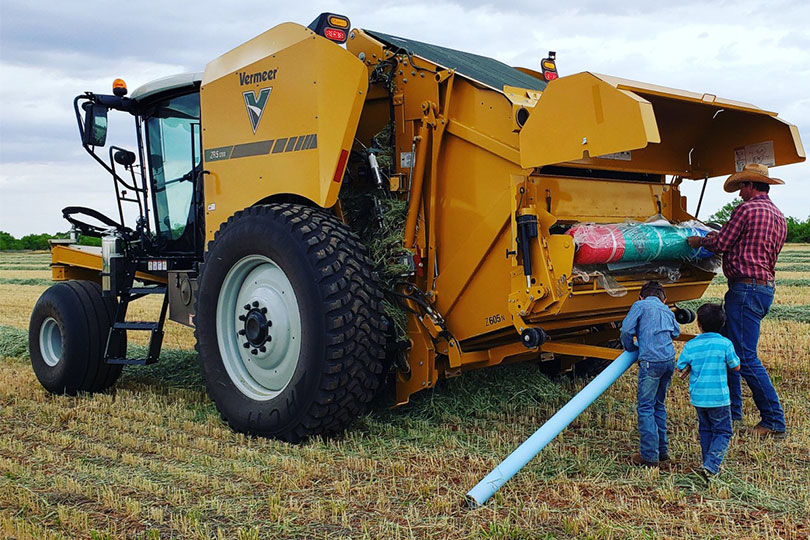By Jennifer Dorsett
Field Editor
A self-propelled baler is how a young Texas couple hopes to help keep their operation running as efficiently as possible.
Texas Farm Bureau members and 2018 Outstanding Young Farmer & Rancher Award winners Justin and Lindsay Hannsz run cattle in Erath County and raise cotton, wheat, sorghum and hay, as well as another cattle herd, in Haskell County.
Currently, Justin is harvesting wheat, planting cotton, baling hay and sowing cover crops, all while caring for the cattle and driving back and forth between Stephenville and Haskell.
The hay operation is a new addition to their business, but things are going so well that he needed more equipment to keep up. So, they recently purchased a Vermeer self-propelled baler—the first of its kind on the market, and coincidentally, the first machine of its kind in Texas, according to Justin.
“Our business was expanding, and I knew I would have to buy another baler and tractor, so the self-propelled baler made sense,” he said. “It does almost twice the work of a conventional baler and tractor.”
Although expensive, he feels the investment is worth it.
“It’s one of those things that wouldn’t necessarily make sense for everybody, but it fits perfectly into what we’re doing with baling a lot of hay and covering a lot of miles to do it,” he said. “I farm all over Haskell County, and it’s not unusual for me to travel 30 miles between fields. The machine can go up to 35 miles per hour on the highway so that really cuts down on my travel time, as well.”
The baler can bale at average speeds of over 12 miles per hour, which saves him time in the field, too.
When the purchase was finalized, Vermeer sent the lead mechanic on the self-propelled baler project from Iowa to give Justin a hands-on tutorial. The mechanic spent three days in Haskell.
“Buying something untested like this is a little risky, but Vermeer is a solid company, and they take a lot of pride in what they build. I was impressed that the lead mechanic and the regional sales representative both came out to make sure things were in order,” Justin said. “Once you figure everything out, it’s a lot easier than running a regular baler. I just set the size of the bale and go. It will stop the machine, wrap the bale, kick out the bale and close the tailgate when a bale is ready. It’s pretty neat.”
For a young farmer trying to get established, Justin said efficiency is key.
Currently, he’s baling wheat straw, something he said he wouldn’t otherwise be able to do.
“I’m doing the wheat straw because I have the machine. I wouldn’t do it otherwise because I’m also busy planting cotton and harvesting wheat, but I can run this a couple of hours at night and be caught up,” he said. “Here, in this part of Texas, the climate is so dry that we do 75 percent of our baling at night—from midnight to early in the morning. Being fully automated, I’m comfortable running it at night where I’d have been much more cautious before.”
In addition to wheat straw, Justin said he will be baling beardless wheat hay, bermudagrass, haygrazer and grain sorghum hay.
“This machine can handle just about anything we throw at it,” he said. “It’s really going to be a game-changer for us.”


Hey; or “Hay”? I saw one of these Vermeer bad boys on the local Vermeer dealers lot in Mandan ND last summer (2019). Not sure if the 1st one went to Texas
Justin said he believes it’s the first of its kind in use in Texas, not that it’s the first machine that was purchased.
I live in Dublin, Texas, have 30 acres of coastal/hay mix that needs to be cut and baled. Hay cutters are too busy or says too small to mess with, etc. We don’t know if you wanted to come look at our field when you are in Stephenville or if it is too small for you. We will have to lease it out for grazing if we can’t get it cut. If you email me back, I will give you our address and tel #’s. Thank you!